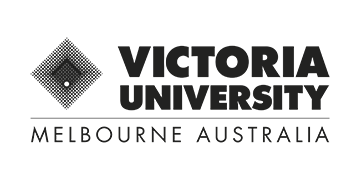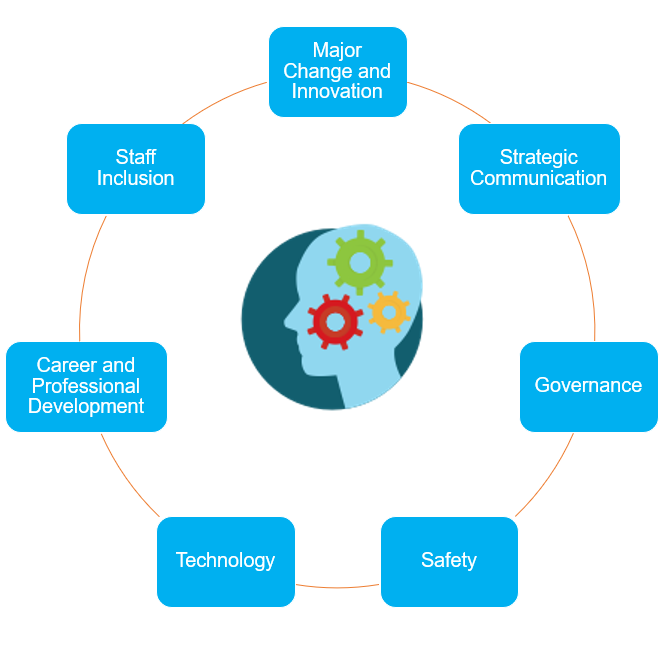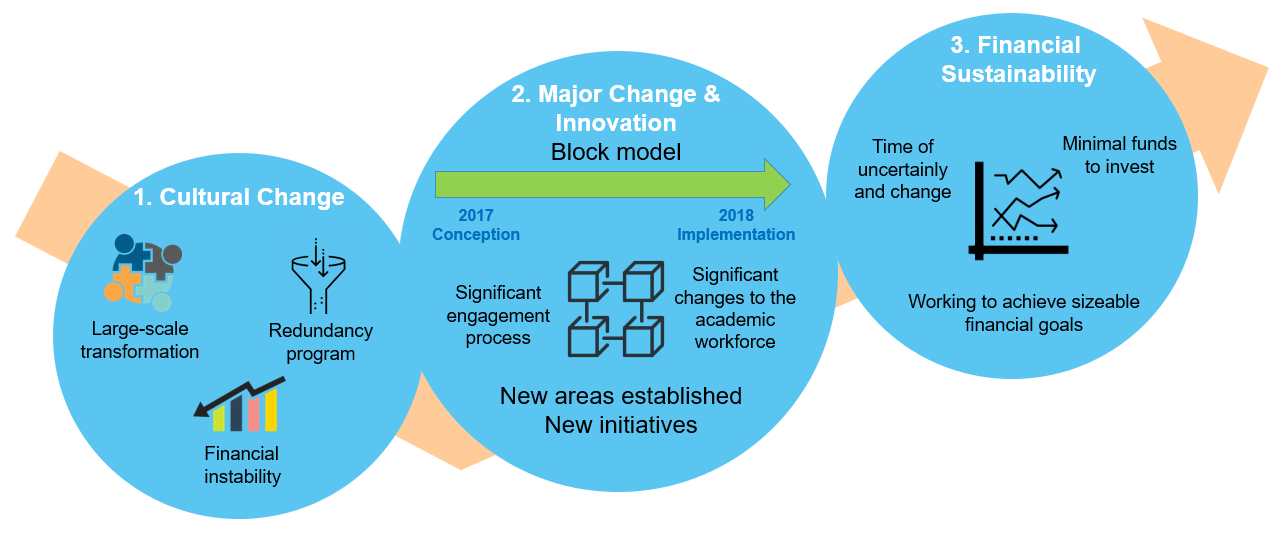Victoria University's Remarkable Transformation
By Echo Fong and Ming Pan
One of Voice Project’s long-term clients, Victoria University (VU), was acknowledged as the winner of the AHEIA/Voice Project Change Award at the AHEIA Benchmarking Conference in September 2019. VU was also a finalist in Voice Project’s all-industries Change Challenge Awards for 2019. These awards recognise organisations which have achieved measurable and meaningful change and successfully uplifted their levels of employee engagement and satisfaction. We would like to congratulate VU again for their remarkable accomplishments!
The above awards reflect and acknowledge VU’s significant and institution-wide transformation in the areas of teaching, research, innovation and staff engagement between 2015 and 2019. Some of VU’s most outstanding achievements during this period include:
Successful launch of the Australian first, revolutionary First Year Block Model of teaching in 2018, which lets first-year students focus on one unit at a time in intensive four-week blocks. Despite being the largest organisational change in VU’s history, the change to the Block Model was completed in only 9 months from conception to implementation, demonstrating VU’s ability to “think big”, be innovative and introduce change rapidly. VU’s Block Model has received numerous accolades in the press due to its innovative approach, such as the Excellence in International Education – University category of the Victorian International Education Awards. The most significant improvement brought by the Block Model was in the retention of students. Furthermore, overall pass rates for Block Model students have improved by 7.9% percentage points to 83.9%.
The Block Model, now known as The VU Way, is now being successfully rolled out in second year undergraduate courses as part of a plan to have undergraduate, postgraduate and VET courses blocked by 2022.
Improvement in student VTAC preferences in 2019, especially for Total Preference 1, which has increased by 13.8% compared to 2018. VU was one of the only two Victorian universities that had positive gains in a declining market.
VU was ranked in the top 2% of universities worldwide in the Times Higher Education world universities rankings.
The VU Staff Survey participation rate increased from 40% in 2015 to 82% in 2018. There were also notable improvements in the survey results, particularly in the areas Organisation Performance (+11%), Change and Innovation (+15%) and Safety (+17%).
A significant turnaround in the University’s financial performance, from an operating deficit in 2015 to a surplus in 2018.
Some other awards received by VU for its innovation and support for workplace diversity and equity between 2017 and 2019 include:
Platinum Winner for Best Blended Learning Model – LearnX Impact Awards
Best Implementation of a Blended Learning Solution – AITD awards
2018 AWEI Participation Award for excellence in LGBTI Workplace Inclusion
Victoria’s 2018 Multicultural Award for Excellence – Business Category
WGEA’s Employer of Choice for Gender Equality citation for 2019.
Below, we asked VU to reflect on their change journey, which began in 2015, and tell us the specific actions that were taken to achieve successful change.
Q&A with Victoria University, the 2019 Voice Project Change Challenge Award Finalist and AHEIA - Change Award Winner
1. Why was there a need for change?
There was significant pressure on the University’s financial stability due to reduced public funding and the tertiary education sector shifting towards a demands-driven, market-based model. This presented major challenges for VU, especially its vocational education and training (VET) business.
The external policy impacts coupled with an organisational operating model that was not fit for purpose placed pressure on VU to immediately reduce costs to ensure financial sustainability, and resulted in several organisational restructures, staff redundancies and a strong financial management strategy which saw limited spending on activities such as staff professional development, travel associated with conferences and even catering.
In 2015, VU commenced an organisation-wide “transformational agenda” as part of its 2016-2020 Strategic Plan. This focused on balancing academic to professional staff ratios in times of financial hardship, as well as significant workforce restructuring.
These factors likely impacted VU’s 2015 Staff Survey participation rate, being at its lowest point since the survey was first implemented in 2009 and an indicator of all-time low staff engagement. The survey results were consistent with where the University was at, and how staff felt in terms of the key improvement areas for VU.
2. What were the actions taken to achieve change?
In 2015, focus groups were held with staff to unpack the Staff Survey results around the key areas for improvement identified at an institution level. Around the same time, VU implemented its new Strategic Plan for 2016-2020, focusing on three key elements: 1) being open and excellent; 2) financial sustainability; and 3) transformational agenda. A key driver for change was the inclusion of the “transformational agenda” within the strategic plan.
Several actions were put in place to address the transformational agenda as well as the improvement areas identified via the Staff Survey, with the aim to shift the culture from one of compliance to one that values staff engagement. These actions were:
Major Change and Innovation, including:
Implementation of the First Year Block Model.
Establishment of the VU Polytechnic to revitalise TAFE at VU. An important part of this was the development of significant capability in industry-leading blended learning.
Establishment of VU Research to lead, manage and administer the University’s research and research training programs. This saw resources directed to research centralised and focused on VU’s key areas of strength.
Establishment of VU Innovations to foster entrepreneurial thinking across the organisation, develop new opportunities in an agile way, and nurture and grow value for VU through encouraging and promoting innovations.
Strategic Communication – quarterly Vice-Chancellor’s Strategic Conversations were put in place, inviting all staff to attend. These Strategic Conversations have a conversational, two-way format, face-to-face or via technology to enable the big issues of the University to be directly discussed between senior executive and staff.
Governance – the establishment of a University Transformation Office to manage organisational wide projects, oversee cost management, and drive the significant program of transformational change projects forward.
Safety – there was improved functioning of safety committees, increased safety training for staff and enhanced safety consultation. A partnership was established with Monash University to create online training modules for Office Ergonomics, Chemical Management and Risk Management. OHS Risk registers were also created.
Technology – a digital strategy was developed and significant investment was placed into technology, including digitisation of student services and library services, introduction of online and blended learning programs, fastest Wi-Fi of all institutes released, updated phone system and student classroom technology, and video-conferencing to training rooms and conference facilities.
Career and Professional Development – additional resources were employed in the Capability & Culture team to develop and implement a new performance management system – VU Develop, central training hub, on-line probation, induction program, leadership and team-building programs, as well as a dedicated mentoring and shadowing program for women in middle to senior roles within VU.
Staff Inclusion – the development of significant strategies focused on inclusion of indigenous staff and cultural awareness, as well as a gender equity strategy. In the lead up to the 2018 Staff Survey, a Staff Benefits and Wellbeing week was held for all staff, which showcased the multiple benefits for staff working at VU. This was well attended.
3. What were the main challenges to achieving positive change at VU?
There were three main challenges:
Cultural change – managing a positive culture ongoing was a huge challenge during the large-scale transformation as financial instability was still driving several redundancy programs.
Pace of major change and innovation – conception to implementation of the First Year Block Model had to happen quickly – within only 9 months from 2017 to the first quarter of 2018. It was the largest change ever experienced at VU and required a significant engagement process with all staff across every department within the University to be successful. It also saw significant changes to the academic workforce with the establishment of Academic Teaching Scholar (teaching-only academics) roles.
Financial sustainability – working together to achieve sizeable and sustainable financial goals during a time of uncertainty and change with minimal funds to invest. A commitment had been made to University Council that VU would return to a positive operating result by the end of 2018.
4. Which factors were the main contributors to VU’s success in achieving change?
First, the University Council and senior executive team had a strong vision to work together to make VU a great place to work.
Second, there has been a shift in mindset, with staff being more willing to embrace change and adapt quickly to a new way of working. Indeed, most staff have engaged with the major changes across the University.
Third, university-wide cross-collaborative working groups were established for several major change projects. All departments worked together with staff from different cohorts (academic, teaching, professional) to achieve positive outcomes, thus signalled a move away from a siloed mentality to an enterprise-level approach. For example, the introduction of numerous cross-functional teams to implement all parts of the First Year Block Model was widely supported and a collaborative team environment was celebrated.
Last but not least, there has been greater communication and consultation between senior management and staff, with the VC’s Strategic Conversations with staff being rolled out on a more regular basis, and more regular updates from senior leaders regarding changes and innovations.
5. Could VU’s change initiatives be applied to other organisations?
VU continues to roll out the Block Model of teaching across both second and third year for students. All courses will be blocked (including postgraduate and vocational education) by the end of 2022. This new, innovative way of teaching, known as The VU Way, was formally launched in March 2019. Such teaching models could potentially be adapted and applied to other tertiary education providers.
Several of the other initiatives that VU has implemented could potentially be replicated in other organisations, for example, more strategic communications, improving technologies, and a greater emphasis on innovation, collaboration and communications during periods of major change.






